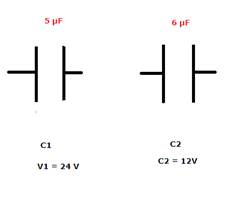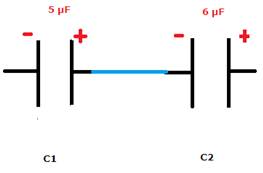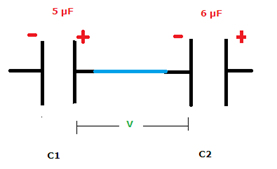A capacitor of capacitance 5.00 μF is charged to 24.0V and another capacitor of capacitance 6.0 μF is charged to 12.0V.
a) Find the energy stored in each capacitor.
b) The positive plate of the first capacitor is now connected to the negative plate of the second nd vice versa. Find the new charges on the capacitors.
c) Find the loss of electrostatic energy during the process.
d) Where does this energy go?

Given:
C1=5 μF
V1=24 V
To calculate the charge present on the capacitor, we use the formula
![]()
where,
c = capacitance of the capacitor and
v = voltage across the capacitor
For first capacitor, the stored charge q1 is given by
![]()
![]()
![]()
Similarly for second capacitor, the stored charge q2 is given by-
![]()
Given, C2=6 μF and V2=12
![]()
![]()
a) Energy stored in each capacitor-
Energy stored in a capacitor is given by
![]()
Where, v = applied voltage
C =capacitance
For capacitor C1, energy stored is given by
![]()
= ![]()
![]()
Similarly, for capacitor C2, energy stored is given by
![]()
![]()
![]()
b) New charges on the capacitors when the positive plate of the first capacitor is now connected to the negative plate of the second nd vice versa

The capacitors are connected as shown on the right hand side.
The positive of first capacitor is connected to the negative of the second capacitor.
So charge flows from positive of first capacitor to the negative of the second capacitor.
Then, the net charge for connected capacitors becomes
![]()
![]()
![]()
Now, let V be the common potential of the two capacitors
Since, charge is conserved, we know that electric charge can neither be created nor be destroyed, hence net charge is always conserved.

From the conservation of charge before and after connecting, we get, common voltage V
![]()
![]()
![]()
We know,
![]()
where v = applied voltage and C is the capacitance
Using above relation, the new charges becomes-
![]()
![]()
![]()
![]()
![]()
![]()
c) Loss of electrostatic energy during the process
Energy stored in a capacitor is given by
![]() 1)
1)
Where, v = applied voltage
C =capacitance
For capacitor C1, energy stored is given by
![]()
= ![]()
Similarly, for capacitor C2 , energy stored is given by
![]()
![]()
![]()
= ![]()
![]() 2)
2)
But given
for c1, actual V1 = 24V
and c2, actualV2 = 12V
Using 1)
![]()
And
![]()
Now, change in energy,![]()
![]()
![]() 3)
3)
From 2) and3)
Loss of electrostatic energy = ![]()
![]()
d) This energy, which is lost as electrostatic energy gets converted and dissipated from the capacitor in the from of heat energy.